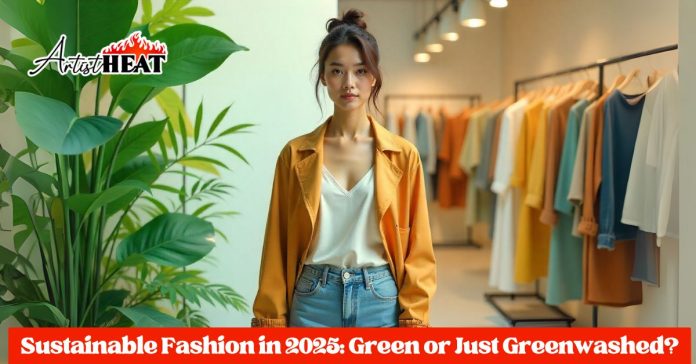Look, we need to talk. While everyone’s busy posting their thrift hauls and preaching about sustainable fashion in 2025, I sit here and wonder whether we are actually doing something positive or just seeing brands become very good at dressing up with their environmental talk.
The world of fashion is in the spotlight at the moment and guess what? It’s complicated. With Taylor Swift releasing merch as fast as I abandon my New Year resolutions, and companies using the term eco-friendly like its going out of style on everything a plastic hanger to a polyester shirt, it is increasingly becoming difficult to separate those that are actually walking the talk and those who succeed in the eco-friendly shuffle.
The Reality Check Nobody Asked For
Here’s what’s actually happening in sustainable fashion in 2025: The sustainability professionals of the 1.7 trillion dollar industry are put into a jam. According to the consumer research, Generation Z is supposed to care about sustainable shopping, but go ahead and demonstrate that to citizens when they shop. A raft of eggs can easily be more expensive than a T-shirt by Shein, Amazon basics, and Forever 21.
True, it is true, we live in the world where the breakfast is more expensive than a whole outfit. Where you stand on avocado toast versus a new wardrobe matters very little when that sinks in.
The statistics are not artificial also. A report (2021) by the Changing Markets Foundation, which had examined garments of major high-street fashion companies to determine the accuracy of their globally promoted sustainability statements, found that 60 per cent of all claims were either deceptive or unverifiable. That is bad but on the worst of them H&M were found to be the worst with the terrifying figure of 96 percent of their claims falling flat.
In essence, whenever H&M bothers to mention that something is conscious, it is highly likely that it is as conscious as my choice to have pizza at breakfast.
The Greenwashing Olympics Are in Full Swing
It is time to wake up to greenwashing in 2025. It is no longer about slapping a green leaf to your logo. Such brands have become innovative and not in a positive manner. Numerous brands stretch the truth or mislead consumers in relation to their sustainability performances, and analysts recommend that consumers must train their minds to be on the lookout of greenwashing.
The sustainable fashion in 2025 landscape is peppered with what I like to call “sustainability theater.” Businesses are staging Oscar award-winning plays, dressing them up in recycled polyester uniforms and carbon-neutralplot lines. In the meantime, greenwashing in fashion is a process when a brand tries to represent themselves as more sustainable than they are because it feels that it knows nothing about sustainable practices and it boasts of its little or no sustainable activities to misinform its audience.
One can look at the example of Zara and its Join Life collection. This rings as a revolution until you figure out it is equivalent to adding bandage on a broken leg. This line-up is just a small part of Zara total product line. Most of the products in Zara are also made through conventional fast fashion strategies with short production cycles, large use of resources and generation of a very large waste products.
What’s Actually Changing (And What Isn’t)
But before you lose all hope and decide to live naked (please don’t), there are some legitimate developments in sustainable fashion in 2025. The regulatory landscape is finally getting its act together, sort of.
The Legal Side of Things
A number of states in the US are formulating groundbreaking laws that have laid emphasis on supply chain mapping and accountability. California also adopted Responsible Textile Recovery Act of 2024 to create an extended producer responsibility program across the state and the Fashion Environmental Accountability Act of 2025 in 2025, which compelled sellers of clothing to set a pupil on their GHG emissions.
Translation: The brands are soon to be served with law suits to their BS, and they are not pleased about it.
Even in Europe, it is even quicker. By January 1, 2025, Member States will have to organise separate collection of textile waste. Each country will have an EPR and each country as a fashion brand you will have to join EPR in each country.
The Innovation Actually Worth Talking About
Some genuinely cool stuff is happening in the sustainable fashion in 2025 space. Regenerative agriculture is a new mindset and operates on new principles of farming, concerned with the health of soils, diversity and storage of carbon in them. Regenerative practices do the opposite and replenish the ecosystem unlike conventional agriculture.
We are even witnessing crazy and crazy, even wild materials that can be described as those right out of a science fiction flick. The architects are becoming increasingly innovative in the use of green materials. Recycled or organic products, cotton-based or linen are recognizable, but did you know that there are pineapple leather bag or mushroom-based biodegradable clothes in 2025?
Mushroom leather? I can not even make mushrooms last a week in my refridgerator and you make handbags out of them.
The Transparency Problem We Can’t Ignore
Here’s where things get really frustrating. Despite all the noise about sustainable fashion in 2025, brands are still playing hide and seek with their actual impact data. The mean rate remained as low as 26 points out of 100 with a 2-point increase since 2022. Overall, the global fashion industry has not managed to achieve much on transparency and the largest fashion brands have only increased the average score to 26% this year which is only a 2% rise compared to last year.
That is akin to passing a D- in sustainability report card and rejoicing that you used to have an F+ the previous year. I assume congratulations.
Most angering is the part? The percentage level of sustainability-linked executive compensation or bonus is only disclosed by 18 percent of large brands. Therefore, when CEOs are cashing in they are not even faking it that their salaries are pegged on whether they are sustainable or not.
What This Means for You (And Your Wallet)
So where does this leave us as consumers trying to navigate sustainable fashion in 2025? This is my no nonsense opinion:
One, assume that marketing is not to be believed. The first red flag would be to have a brand hollering at you about how sustainable they are. The most sustainable brands that I have known of are more discreet, perhaps, in their lack thereof since they are trying to get the work done rather than talk about the work.
Second, fashion experts may recommend the following thing to do in order to help the environment, which is to say, “Less is always more.” Innovative idea, I am aware.
Third, search through the receipts. A blockchain technology is a safe, unalterable record of the supply chain of a product, according to its path to the consumer. Such technology enables brands to ensure authenticity of the claims they have. Maybe don not buy the shirt, is a brand is not able to demonstrate to you how they produced your shirt.
The Reality of Change in 2025
Here’s what I’ve learned from diving deep into sustainable fashion in 2025: we are in this strange in-between place where there are brands making sincere efforts to change their ways of doing things, whereas others have only developed a more deft skill in faking.
By 2025, net zero emissions will be a less consuming issue than the burning desire to turn a profit in an excessively competitive environment. Translation: at the end of the day, money will use its voice, even above mother earth.
But there is hope. The demand of consumers is indeed driving the pace of fashion to sustainable and circular, as the next generations of buyers (Gen Z and younger millennials) are changing the rules of what constitutes a consumer of conscience.
The Bottom Line
Sustainable fashion in 2025 isn’t a simple story of good versus evil. It is not so clean cut. There are real innovators working to make mushroom-based clothing, lawmakers who are at last bringing heat to brands to be truthful, and citizens who are more likely to demand that brands are not messing around.
We have, however, brands that are virtuosos when it comes to sustainability theatre, rules that have yet to come down on people with teeth and a core business model that continues to lay their primary focus on ensuring that they do grow before all things.
My advice? Be a little suspicious, read around and think that the most eco-friendly piece of clothing will be the one you already have. We will continue seeing this green-or-greenwashed song and dance until the business discovers a way of making this saving the planet possible and profitable.
The future of sustainable fashion in 2025 isn’t written yet. It would be another matter though if we all continue to bring brands to account and insist on genuine change rather than another sugar-coated fast fashion promotional campaign, then we might, just might, get somewhere other than the same old fast fashion hell, only prettier.
Without further ado, you can excuse me now, I must go and change into one of my three outfits that I have been repeating the last twelve months. It is a capsule wardrobe and it is very deliberate … thank you so much.

